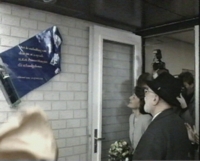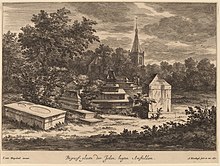History of the Jews in Amsterdam

The History of the Jews in Amsterdam focuses on the historical center of the Dutch Jewish community, comprising both Portuguese Jews originally from both Spain and Portugal and Ashkenazi Jews, originally from central Europe. The two separate groups have had a continuing presence since the seventeenth century.[1] Amsterdam has been called a Jerusalem of the West and the "Dutch Jerusalem".[2] The Holocaust in the Netherlands devastated the Jewish community, with the Nazis murdering some 75% of the approximately 80,000 Jews at time present in Amsterdam, but the community has managed to rebuild a vibrant and living Jewish life for its approximately 15,000 present members.[citation needed]
Conversos and Portuguese Jews
At the end of the sixteenth century and beginning of the seventeenth, Portuguese Jews began settling in Amsterdam. They self identified not as Sephardic Jews or Sephardim,
Collectively, they brought economic growth and influence to the city as they established an international trading hub in Amsterdam during the 17th century, the so-called Dutch Golden Age. Perhaps the most notable example of Sephardic Jews in Amsterdam are the Curiel family, namely Jeromino Nunes da Costa (alias Moses Curiel),[5] son of Jacob Curiel.[6] Curiel was the single largest financial contributor to the building of the Portuguese Synagogue in Amsterdam.[7]
In 1593,
The formal independence from Spain of the Dutch Republic, by the
Ashkenazim
The first

Only in 1671 did the large Ashkenazi community inaugurate their own synagogue, the Great Synagogue,
The Holocaust
Occupation of Amsterdam by Nazi Germany began 10 May 1940.[16] Amsterdam, the largest city in the Netherlands,[17] had an estimated 75–80,000 Jews, approximately 53–57% of the country's Jewish population.[18][19] Among them was the German Jewish family of Anne Frank.
Approximately 25–35,000 of the Dutch Jews were refugees.[20][21] but most of these were not in Amsterdam.[22]
Although less than 10 percent of Amsterdam's population was Jewish, there were two seemingly contradictory outcomes:
- a general strike against mass Nazi arrests of Jews[17][23]
- about 75–80% of the Jewish population was deported and murdered.[24][25]
Part of the Nazi action plan included consolidating the Dutch Jewish population into Amsterdam, prior to the "Final Solution."[17] Canadian Forces liberated Amsterdam in early 1945.
Prominent Jewish politicians
Six of Amsterdam's mayors were Jewish. Job Cohen was runner-up for the award of World Mayor in 2006.[26][27]
Cheider

In 1964
Jewish community in the 21st century
Most of the Amsterdam Jewish community (excluding the Progressive and Sephardic communities) is affiliated to the
Contemporary synagogues
There are functioning synagogues in Amsterdam at the following addresses.
- Gerard Doustraat 238 (the Gerard Dou Synagogue)[31] (congregation Tesjoengat Israël)[32]
- Gerrit van der Veenstraat 26 (the Kehillas Ja'akov)[33]
- Jacob Obrechtplein/Heinzestraat 3 (the synagogue is called the Raw Aron Schuster Synagogue)[34]
- Lekstraat 61 (the Charedi)[34]
- Nieuwe Kerkstraat 149 (called the Russische sjoel or Russian Shul)[34]
- Vasco da Gamastraat 19 (called the Synagogue West due to its location in the west of Amsterdam)
- There is also a synagogue present in Jewish nursing home Beth Shalom[35]
- Progressive
- Nederlands Verbond voor Progressief Jodendom (Progressive)
- Jacob Soetendorpstraat 8[36]
- Reconstructionist
- Beit Ha'Chidush (Jewish Renewal/Reconstructionist Judaism/Liberal Judaism)
- Nieuwe Uilenburgerstraat 91 (called the Uilenburger Synagoge)[37]
- Sephardic
- Sephardic Judaism)
- Mr. Visserplein 3 (the Esnoga Synagogue)
Kashrut in Amsterdam
Kosher food is available in Amsterdam restaurants and shops. [38] There is the possibility of eating kosher in Restaurant Ha-Carmel,[39] and the well-known Sandwichshop Sal-Meijer.[40]
Jewish culture

The Joods Historisch Museum[41] is the center of Jewish culture in Amsterdam. Other Jewish cultural events include the Internationaal Joods Muziekfestival (International Jewish Music Festival)[42] and the Joods Film Festival (Jewish Film Festival).[43]
The Anne Frank House hosts a permanent exhibit on the story of Anne Frank.
Jewish cemeteries

Six Jewish cemeteries exist in Amsterdam and surroundings, three

See also
- History of the Jews in the Netherlands
- Jodenbreestraat
- List of Dutch Jews
- National Holocaust Names Memorial (Amsterdam)
References
- ^ a b NIHS General Information Archived 2007-09-27 at the Wayback Machine. Accessed July 17, 2007
- ^ Baron, S.W. A Social and Religious History of the Jews, vol. 15, Late Middle Ages and Era of European Expansion, 1200-1650 chap. 63 "Dutch Jerusalem". New York: Columbia University Press 1952.
- ^ Swetschinski, Daniel M. Reluctant Cosmopolitans: The Portuguese Jews of Seventeenth-Century Amsterdam. London: Littman Library of Jewish Cibilization 2000, xii
- ^ Bodian, Miriam. Hebrews of the Portuguese Nation: Conversos and Community in Early Modern Amsterdam. Bloomington: Indiana University Press 1997
- ^ Abas, W. "Mose Curiel Abas (alias: Jeronimo Nunes Da Costa) (1620-1697) » Stamboom Abas » Genealogy Online". Genealogy Online. Archived from the original on 2019-10-01. Retrieved 2019-10-01.
- JSTOR 41442146.
- ^ "Woonhuis familie Nunes da Costa (Residence of the Nunes Da Costa family)". www.iamsterdam.com. Archived from the original on 2019-10-01. Retrieved 2019-10-01.
- ^ [https://www.theobakker.net/pdf/synagogen.pdf Hoe Amsterdam Mokum werd
- ^ BARUCH SPINOZA
- ^ a b Ashkenazi Jews in Amsterdam Archived 2007-09-29 at the Wayback Machine. Edward van Voolen. Accessed July 21, 2007
- ^ "Great Synagogue". Archived from the original on July 6, 2007. Retrieved July 21, 2007.
- ^ Etching showing the Portuguese and High German Synagogues[permanent dead link], at the Amsterdam City Archives
- ^ [1] Archived July 6, 2007, at the Wayback Machine
- ^ "Dritt Sjoel". Archived from the original on July 6, 2007. Retrieved July 21, 2007.
- ^ [2] Archived September 27, 2007, at the Wayback Machine
- ^ Linda M. Woolf, Ph.D. "Survival and Resistance: The Netherlands Under Nazi Occupation". Archived from the original on 2018-06-26. Retrieved 2018-07-06.
- ^ a b c "Amsterdam". Archived from the original on 2018-07-06. Retrieved 2018-07-06.
- ^ Dutch Census tables, 1930, 1941
- ^ Croes, Marnix (Winter 2006). "The Holocaust in the Netherlands and the Rate of Jewish Survival'"
- ^ Voolen, Edward van. "Askhenazi Jews in Amsterdam"
- ^ "Administrators of the German occupied Netherlands during WW II". Archived from the original on 2004-01-24.
- ^ A rare photo of a round-up of Jews in 1943 in the Uiterwaardenstraat. [permanent dead link]
- ^ lasting 3 days
- ^ Tammes, Peter "Surviving the Holocaust: Socio-demographic Differences Among Amsterdam Jews
- ^ The percentage of Pre-WW II Dutch Jewry surviving is estimated as under 20%
- ^ "Amsterdam closes a window on its red-light tourist trade" Archived 2016-10-18 at the Wayback Machine by Anushka Asthana, The Observer, September 23, 2007.
- ^ "John So, Lord Mayor of Melbourne wins the 2006 World Mayor Award". www.worldmayor.com. 2006-12-05. Archived from the original on 2012-05-01. Retrieved 2009-04-08.
- Cheider]
- ^ van Kemenade., J (4 February 1994). "Margriet opent Cheider" (PDF). Nieuw Israelietisch Weekblad. Archived from the original (PDF) on 21 January 2016. Retrieved 23 April 2012.
- ^ Jewish Amsterdam Archived 2007-06-29 at the Wayback Machine. Accessed July 20, 2007
- ^ "Jewish Historical Museum - Gerard Dou Synagogue". 29 September 2007. Archived from the original on 29 September 2007.
- ^ "Gerarddou.org". Gerarddou.org. Archived from the original on 2012-11-16. Retrieved 2012-12-11.
- ^ "De Gerrit". Archived from the original on 2018-06-02. Retrieved 2022-03-01.
- ^ a b c "Synagogues and Services - Chabad Central Amsterdam - בית חב"ד מרכז אמסטרדם". www.chabadamsterdamcenter.com. Archived from the original on 2013-08-15. Retrieved 2013-11-14.
- ^ Siraad.nl Archived 2003-03-30 at the Wayback Machine (in Dutch)
- ^ "Beeldbank.amsterdam.nl". Beeldbank.amsterdam.nl. 1998-12-04. Archived from the original on 2011-07-26. Retrieved 2012-12-11.
- ^ "Jewish Historical Museum - Uilenburg synagogue". 29 September 2007. Archived from the original on 29 September 2007.
- ^ "NIK.nl". NIK.nl. Archived from the original on 2016-03-05. Retrieved 2012-12-11.
- ^ "Hacarmel.nl". Hacarmel.nl. Archived from the original on 2012-11-30. Retrieved 2012-12-11.
- ^ "Sal-meijer.com". Sal-meijer.com. Archived from the original on 2013-01-02. Retrieved 2012-12-11.
- ^ "Joods Historisch Museum". Jhm.nl. Archived from the original on 2011-02-26. Retrieved 2012-12-11.
- ^ "Joodsmuziekfestival.nl". Joodsmuziekfestival.nl. Archived from the original on 2012-12-26. Retrieved 2012-12-11.
- ^ "Joodsfilmfestival.nl". Joodsfilmfestival.nl. Archived from the original on 2012-11-30. Retrieved 2012-12-11.
- ^ "Pagina niet gevonden / Page not found -". 4 March 2016. Archived from the original on 4 March 2016.
{{cite web}}: Cite uses generic title (help)[full citation needed] - ^ "Pagina niet gevonden / Page not found -". 3 March 2016. Archived from the original on 3 March 2016.
{{cite web}}: Cite uses generic title (help)[full citation needed] - ^ "Amsterdam Diemen cemetery". Jhm.nl. Archived from the original on 2013-03-07. Retrieved 2012-12-11.
- ^ "Portuguese cemetery Beth Haim". Jhm.nl. Archived from the original on 2013-03-27. Retrieved 2012-12-11.
- ^ a b "Begraafplaats Gan Hasjalom". Archived from the original on September 29, 2007. Retrieved November 18, 2007.
Sources
- This article incorporates text from the GFDL.
Further reading
- Berger, Shlomo. "East European Jews in Amsterdam: Historical and Literary Anecdotes." East European Jewish Affairs 33.2 (2003): 113–120. covers 1630 to 1952
- Bodian, Miriam. Hebrews of the Portuguese Nation: Conversos & Community in Early Modern Amsterdam (1997), 219 pp. covers 1600 to 1699. ISBN 0253332923
- Hofmeester, Karin. Jewish Workers & the Labour Movement: A Comparative Study of Amsterdam, London & Paris, 1870-1914 (2004).
- Israel, Jonathan I. "The Economic Contribution of Dutch Sephardi Jewry to Holland's Golden-Age, 1595-1713." Tijdschrift voor geschiedenis 96.4 (1983): 505–535. in English.
- Kaplan, Yosef. "The Curaçao and Amsterdam Jewish Communities in the 17th and 18th Centuries." American Jewish History 72.2 (1982): 193–211.
- Klooster, Wim. "Communities of port Jews and their contacts in the Dutch Atlantic World." Jewish history 20.2 (2006): 129–145.
- Leydesdorff, Selma; and Frank Heny. We Lived with Dignity: the Jewish Proletariat of Amsterdam, 1900-1940 (1995), 278 pp.
- Nadler, Steven M. "The Excommunication of Spinoza: Trouble and Toleration in the" Dutch Jerusalem"." Shofar: An Interdisciplinary Journal of Jewish Studies 19.4 (2001): 40-52.
- Sonnenberg-Stern, Karina. Emancipation & Poverty: The Ashkenazi Jews of Amsterdam, 1796-1850 (2000) 236 pp.
- Singer, Isidore, and Cyrus Adler, eds. (1916). The Jewish Encyclopedia. pp. 536–45.
{{cite book}}:|author=has generic name (help)CS1 maint: multiple names: authors list (link) - Snyder, Saskia Coenen. "A narrative of absence: monumental synagogue architecture in late nineteenth-century Amsterdam." Jewish History 25.1 (2011): 43–67.
- Sutcliffe, Adam. "Identity, space and intercultural contact in the urban entrepôt: The Sephardic bounding of community in early modern Amsterdam and London." Jewish Culture and History 7.1-2 (2004): 93-108.
- Tammes, Peter. "'Hack, pack, sack': occupational structure, status, and mobility of Jews in Amsterdam 1851–1941." Journal of Interdisciplinary History 43.1 (2012): 1-26. ()
- Tammes Peter. “Jewish-Gentile intermarriage in pre-war Amsterdam.” History of the Family 15.3 (2010): 298–315. (
- Tammes, Peter. “Residential segregation of Jews in Amsterdam on the eve of the Shoah.” Continuity and Change 26.2 (2011): 243–270. ()
- Tammes, Peter. "Surviving the Holocaust: socio-demographic differences among Amsterdam Jews." European Journal of Population 33.3 (2017): 293–318. ()
External links
- Esnoga Website
- Jewish and Kosher Amsterdam
- Information on the NIHS
- Jewish history of Amsterdam
- Jewish Historical Museum
- United States Holocaust Memorial Museum - Amsterdam
- Amsterdam-based Jewish webshop includes info and Dutch-languages books on Jewish Amsterdam
- Story of a Dying Community: A Diary from the Amsterdam Jewish Community from the End of World War II
- The Jewish Community of Amsterdam, The Museum of the Jewish People at Beit Hatfutsot
